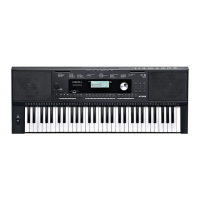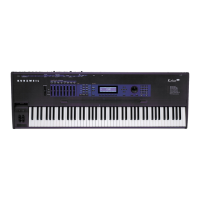With the MIDI functions you can expand your musical possibilities.
This section will let you know what MIDI is, and what it can do, as well
as how you can use MIDI on your instrument.
What's MIDI?
1. MIDI (short for Musical Instrument Digital Interface) allows a wide
variety of electronic musical instruments, computers and other
related devices to connect and communicate with one another.
MIDI carries event messages that specify notation, pitch and
velocity, control signals for parameters such as volume, vibrato,
audio panning, and program change information to change the voice
selections.
2. The instrument can output the real-time playback information via
MIDI messages and control external MIDI devices. The instrument
can also accept incoming MIDI messages and generate sound
accordingly.
Note:
This instrument has a USB(DEVICE) terminal, which can be connected
to a PC as an MIDI input or MIDI output. This can not be connected with
another instrument, unless the instrument has a USB host terminal.
The main application of MIDI
1. Used as a tone generator
This instrument can receive MIDI data from computer, and execute
MIDI controls to change channels, change voices, add effect and
make sound and so on. Refer to MIDI Implementation Chart for more
MIDI controls.
2. Used as a MIDI Keyboard
When you play the keyboard, change the voices or turn the DSP
on/off, the instrument will send MIDI data to the computer, which will
be saved as records.(It only records your keyboard performance
when playing along with accompaniment.) You can edit the records
on the computer, such as changing the channels or voices, adding
DSP effects. Then play back the records with the instrument or other
sound source (such as a sound card). You can play the keyboard
along with the playback. Refer to MIDI Implementation Chart for
more MIDI controls.
3. Select a MIDI Device
To use the USB port of the instrument, you need to set the software
on your computer. For example, set the Cakewalk Pro Audio MIDI
software under WINDOWS XP operating system.
Open the Cakewalk Pro Audio MIDI software.
Set the USB AUDIO DEVICE either as the MIDI Input port on the left of
the pop-up window, or as the MIDI Output port on the right, then press
“OK”.
Alternatively, you can select the MIDI device on the TOOLS MIDI
DEVICES menu of Cakewalk. Make the same settings when using
other similar MIDI software.
30
MIDI

